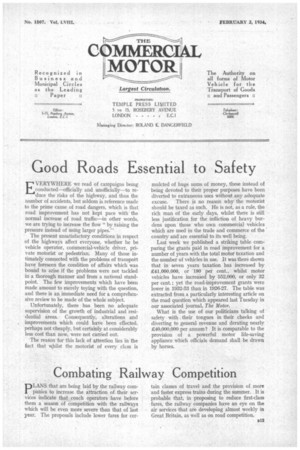Good Roads Essential to Safety
Page 27

If you've noticed an error in this article please click here to report it so we can fix it.
EVERYWHERE we read of campaigns being conducted—officially and unofficially—to reduce the risks of the highway, and thus the number of accidents, but seldom is reference made to the prime cause of road dangers, which is that road improvement has not kept pace with the normal increase of road traffic—in other words, we are trying to increase the flow" by raising the pressure instead of using larger pipes."
The present unsatisfactory conditions in respect of the highways affect everyone, whether he be vehicle operator, commercial-vehicle driver, private motorist or pedestrian. Many of those intimately connected with the problems of transport have foreseen the condition of affairs which was bound to arise if the problems were not tackled in a thorough manner and from a national standpoint. The few improvements which have been made amount to merely toying with the question, and there is an immediate need for a comprehensive review to be made of the whole subject.
Unfortunately, there has been no adequate supervision of the growth of industrial and residential areas. Consequently, alterations and improvements which could have been effected, perhaps not cheaply, but certainly at considerably less cost than now, were not carried out.
The reason for this lack of a,ttention lies in the fact that whilst the motorist of every class is mulcted of huge sums of money, these instead of being devoted to their proper purposes have been diverted to extraneous uses without any adequate excuse. There is no reason why the motorist should be taxed as such._ He is not, as a rule, the rich man of the early days, whilst there is still less justification for the infliction of heavy burdens upon those who own commercial vehicles which are used in the trade and commerce of the country and are essential to its well being.
Last week we published a striking table comparing the grants paid in road improvement for a number of years with the total motor taxation and the number of vehicles in use. It was there shown that in seven years taxation has increased by £41,000,000, or 190 per cent., whilst motor vehicles have increased by 552,000, or only 32 per cent. ; yet the road-improvement grants were lower in 1932-33 than in 1926-27. The table was extracted from a particularly interesting article on the road question which appeared last Tuesday in our associated journal, The Motor.
What is the use of our politicians talking of safety with their tongues in their cheeks and diverting to general revenue and clerating nearly £40,000,000 per annum? It is comparable to the provision of a powerful motor life-saving appliance which officials demand shall be drawn by horses.




























































































